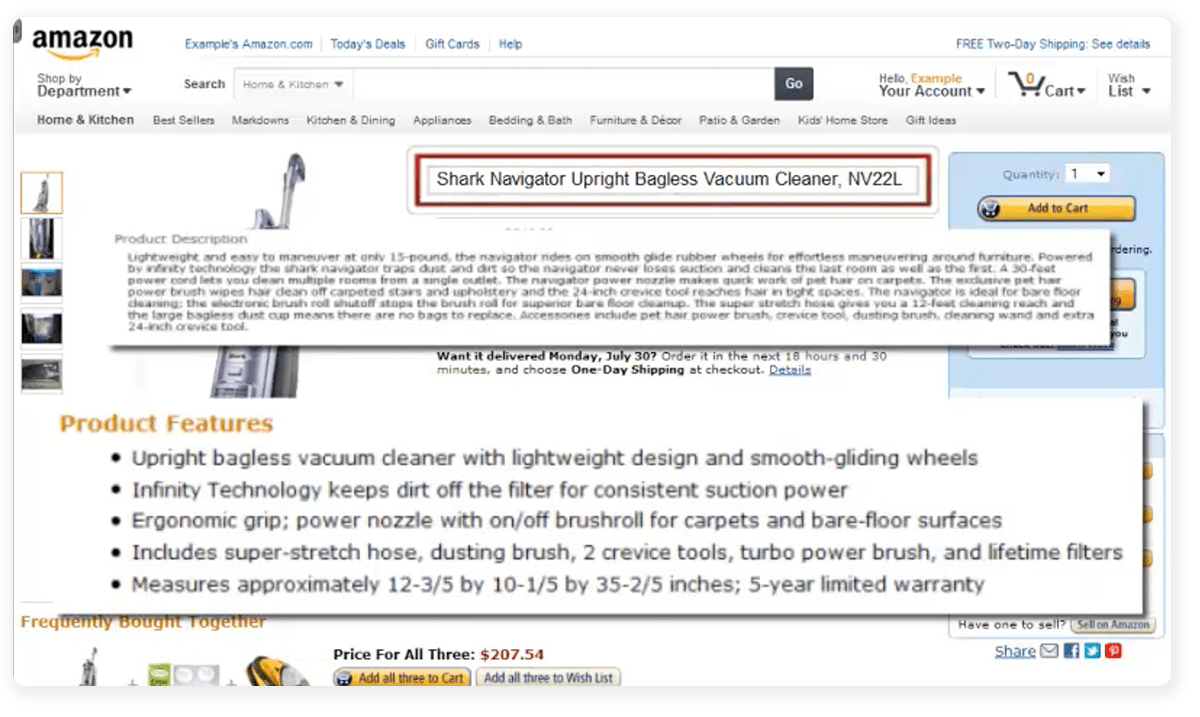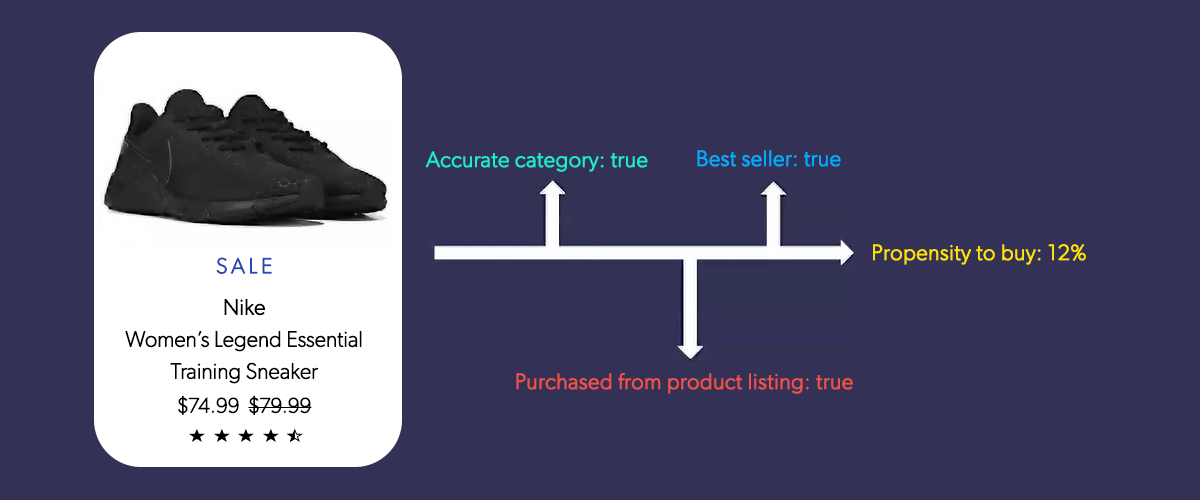It’s arguable that organic traffic is the most valuable marketing channel there is. But there’s a cold war going on between tech giants, with your product data caught in the middle.
Fifty-three percent of trackable website traffic is organic—and over 25% of users click the first result, with diminishing returns the further you drop down the page. But which page do you try to rank best on: Amazon, or Google? And what if that’s a trick question?
To explain what’s going on, why you should care, and what to do, first we need to explain how Amazon changed the rules—by standardizing them.
How Market Places Divert Ecommerce Search
Today, 49% of digital shoppers start with Amazon when looking to make a purchase.
Many books discuss Amazon’s meteoric rise to fame due to its ecommerce platform. Our interest lies in all of the product data they’ve amassed, powering their ‘customer-centric’ mindset. To rank well, Amazon encourages brands to upload a large catalog size. Amazon also encourages them to externally promote their Amazon listings, driving sustained sales over a long period. By hosting most, if not all, of those merchants’ catalog data, Amazon gets a peek behind the curtain into those businesses’ offerings and customers.

By enforcing a standard on all marketplace participants, Amazon can easily index and analyze data around shopper behavior. This grants an overwhelmingly large view into different markets, allowing them to position their products well ahead of the competition. And even ahead of the merchants who sell on their website!
To further their product data collection efforts, Amazon will also outbid brands for advertisement space on Google. Since shoppers often click only on the first result, this keeps consumers coming back to its site. They can then offer shoppers competitors’ products or even their own. And these, due to its ever-growing understanding of the market, are more than competitively designed and priced.
One of Google’s core revenue streams is advertisement; with over 70% of the (desktop) search market share (that number increases to 85% on mobile), it’s the most popular search engine in the world. And Amazon’s data-hungry strategy puts Google squarely in its sights.
After all, why should advertisers spend their budgets on Google if they aren’t going to get the expected results?
Google Strikes Back
Without a captive platform like Amazon, Google has really found itself in a pickle. But they aren’t sitting idle. To restore its advantage, Google has wholeheartedly embraced its role as the friend of ecommerce businesses. They offer analytics, tag management, catalog management, and SEO optimization. Perhaps Google’s biggest selling point is that it isn’t positioning itself as a threat. They’re one of many racetracks that serves your product content to potential shoppers.
Google has significant motivation to help vendors increase their conversion rate. After all, improved conversion rates make a strong argument for more advertisement spend!
As a result, Google has recently partnered with Shopify and WooCommerce, which have a combined 40% of the merchant market (in volume, not value). Merchants on these platforms, using Google tools, can standardize their catalogs and push products onto Google’s SERPs. This benefits Google with a large vendor base and clean data. Thereby allowing them to place relevant product advertisements above Amazon’s on their own SERPs. However, remember that merchants on these platforms tend to have very simple use cases and simple catalogs. Complex product taxonomies, the need to support local store availability, a large number of product attributes, as well as customer-specific pricing and entitlements (typical in B2B), all fall outside the scope of these platforms.
Clean Product Data Optimized for Discovery are Key
An online product catalog isn’t just the face your customers see when searching for your business—catalogs also feed your ecommerce store analytics. By standardizing this information, it doesn’t just make it easier for customers to find what they’re looking for. It also makes it easier for you to see how customers are interacting with different products, as well as what obstacles might be steering them away from a particular product.
While 90% of shoppers expect an online shopping experience to be equal to or exceed that of an in-person one, there are still some hurdles to overcome. Forty-seven percent struggle with search, 43% find website navigation unhelpful, and 42% have difficulty finding information, period. Doesn’t sound like a great shopping trip, right?

So how do you fix it?
There are three things to keep in mind when attempting to standardize your product catalog: correctness, completeness, and relevance.
- Correctness is table stakes. Product images, descriptions, and other details such as pricing should be about the product listed and not another. According to a study from Episerver, 98% of shoppers have been dissuaded from completing a purchase because of incomplete or incorrect data. So, remember to check, double check, and triple check product page attributes and content.
- Completeness means providing the user with all the product information needed to make a decision—that same Episerver survey found that another 32% of consumers were dissuaded from a purchase every time they didn’t get all the information they needed to feel confident about their decision. This can include availability, ratings, or sizing charts, just as a few examples. It can also include rich content that lives outside your product catalog such as how-to videos or expert articles.
- Relevance means a shopper’s search results turn up what they’re looking for— they can easily drill down on the attributes most meaningful to that product category using faceted search and they always see real-time inventory to have an item shipped or to be picked up at a location near them.
So Where Do You Start?
As Amazon taught us, your approach to indexing and search play a key role in delivering on the above. Firstly, the data onboarding process should be generic so it is able to assess, detect, report on, and address all the potential issues of a catalog where data is:
- Missing
- Broken
- Incomplete
- Wrong
- Outdated
- Irrelevant
- Etc.
If something is missed in this process, then your search analytics should immediately point you to those issues. For example, FleetPride, a Coveo customer, quickly realized that 20,000 products were missing from their ecommerce website by simply looking at the number of searches with no results that appeared in their analytics dashboard.
Next, the way that data is set up and optimized for search can be the difference between success and failure. Your ecommerce catalog is more than just rows of SKUs—it represents products that respond to the needs of specific audiences. The main goal is to reduce search friction, improve product discoverability, and provide relevant filters and sorts to your buyers and shoppers.
Bigger Catalog? Look For These Four Features
Although smaller catalogs are known to be simpler and cleaner, larger catalogs tend to get messy. Some of the search features that are important to consider for larger or more complex commerce catalogs include:
Robust Indexing
You want to be able to reproduce your catalog in all its complexity in a way that can be used in search queries without creating complex nesting rules and conditions that the catalog specialist is burdened to manage. As an index is not flat, the ability to build relationships between products and availability or attributes at indexing and subsequently at query time is essential.
Your commerce catalog therefore should be the junction between the configuration and the products themselves. Some of these indexed items, such as products, are meant to be searchable, while others will never be returned in a search, but will be used to contextualize the search query, such as availability, variants, and pricing—delivering relevance.
Updating Single items
Catalogs are composed of sellable items. When these items are no longer available, out of stock, or offered at a different price, they need to be updated, fast. The ability to add or remove a single product without the need to re-index the entire catalog is essential. Pushing single items in real time means less calls made to the index. This ensures the freshness of products in your commerce storefront.
Updating Partial Items
For the same reason as outlined above, modifications to your sellable items need to be updated fast and in real-time. Rather than re-creating an entire item every time something changes, being able to simply update an associated field, such as adding a new color or size for a current product will reduce the maintenance of your catalog which becomes important when large catalogs are in play.
Standardizing Field Mapping
Every catalog will have its own set of metadata; however, mapping these to standardized generic fields creates a whole new world of possibilities. It enhances machine learning models so that they become more effective, and provides for better analytics gathering and reporting and extends merchandising capabilities as well.
Collect Product Data, Feed Your Analytics, Grow Your Business
Catalog management and clean data are at the heart of winning more ecommerce business. Whether focused on cross-selling or upselling, inventory management, or product ratings, clean product data allows you to sell your products and services more effectively.
Organized, clean data paired with analytics provides the insight you need to understand consumer behavior—what path is taking them to certain purchases, and what obstacles might be stopping them. When descriptions, pictures, and attributes are clean and consistent, it’s easier to see how customers are interacting with your online store. This, in turn, feeds your product taxonomy.
But it doesn’t end there. You can further improve your selling ability by augmenting this data collection with artificial intelligence and machine learning. This empowers shoppers with predictive queries and real-time recommendations, even for cold start shoppers.
We’ll dig into how an organized catalog enhances AI and ML—and how that enhances your CX—in our next piece.
Dig Deeper
Ecommerce has grown leaps and bounds during the pandemic, but have their customer experiences improved as well? Find out what makes a relevant ecommerce experience.
Are you dreaming of a new (better?) search solution for your site, but not sure where to start? We’ve got six questions to ask yourself and vendors when evaluating options on the market. If you’re curious about the Coveo Relevance platform, try out a demo!

